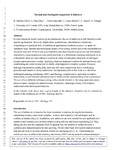Mostrar o rexistro simple do ítem
Thermal and rheological comparison of adhesives
| dc.contributor.author | Sánchez Silva, Bárbara | |
| dc.contributor.author | Díaz-Díaz, Ana-María | |
| dc.contributor.author | Tarrío-Saavedra, Javier | |
| dc.contributor.author | López-Beceiro, Jorge | |
| dc.contributor.author | Gracia-Fernández, Carlos | |
| dc.contributor.author | Artiaga, Ramón | |
| dc.date.accessioned | 2024-01-17T13:08:03Z | |
| dc.date.available | 2024-01-17T13:08:03Z | |
| dc.date.issued | 2019-10-10 | |
| dc.identifier.citation | Sánchez-Silva, B., Díaz-Díaz, A., Tarrío-Saavedra, J. et al. Thermal and rheological comparison of adhesives. J Therm Anal Calorim 138, 3357–3366 (2019). https://doi.org/10.1007/s10973-019-08882-6 | es_ES |
| dc.identifier.issn | 1588-2926 | |
| dc.identifier.uri | http://hdl.handle.net/2183/34948 | |
| dc.description | This version of the article has been accepted for publication, after peer review and is subject to Springer Nature’s AM terms of use, but is not the Version of Record and does not reflect post-acceptance improvements, or any corrections. The Version of Record is available online at: https://doi.org/10.1007/s10973-019-08882-6 | es_ES |
| dc.description.abstract | [Abstract]: In some industrial sectors such as naval construction, the use of adhesives is still limited to some specific applications. However, shipbuilders, academia and classification societies are cooperating to expand the field of certificated applications of adhesive joints. As a part of a validation study, thermal and rheological studies of the curing process and of the cured adhesives should be included. While a neat glass transition and other relaxation processes can be normally identified by ramp temperature tests performed both on a differential scanning calorimeter or on a rheometer, there are some adhesive systems in which several glass transitions or melting or crystallization processes overlap. Applying a thermal treatment to delete the thermal history and conditioning are common practices to clarify what happens in complex systems. However, although that practices usually help, there are still some complexities due to overlapping processes that cannot be easily understood. An important point of this work is to show how differential scanning calorimetry (DSC) and rheology complement to each other in order to demonstrate several thermal relaxations and to obtain a better understanding of the cure process. The use of two different techniques along with a careful election of the setup parameter values allows to better interpret the thermal events. In addition, thermogravimetry (TG) helps to understand some rheological behaviors. In the end,this work shows how a good insight of the adhesive properties can be obtained by means of the combined use of DSC, rheology and TG. | es_ES |
| dc.description.sponsorship | This research has been partially supported by the Spanish Ministry of Science and Innovation, Grants MTM2014-52876-R and MTM2017–82724-R and by UMI UDC-Navantia | es_ES |
| dc.language.iso | eng | es_ES |
| dc.publisher | Springer | es_ES |
| dc.relation | Info:eu-repo/grantAgreement/MICINN/Plan Estatal de Investigación Científica y Técnica y de Innovación 2013-2016/MTM2014-52876-R/ES/INFERENCIA ESTADISTICA COMPLEJA Y DE ALTA DIMENSION: EN GENOMICA, NEUROCIENCIA, ONCOLOGIA, MATERIALES COMPLEJOS, MALHERBOLOGIA, MEDIO AMBIENTE, ENERGIA Y APLICACIONES INDUSTRI | es_ES |
| dc.relation | Info:eu-repo/grantAgreement/MINECO/Plan Estatal de Investigación Científica y Técnica y de Innovación 2013-2016/MTM2017-82724-R/ES/ INFERENCIA ESTADISTICA FLEXIBLE PARA DATOS COMPLEJOS DE GRAN VOLUMEN Y DE ALTA DIMENSION | es_ES |
| dc.relation.uri | https://doi.org/10.1007/s10973-019-08882-6 | es_ES |
| dc.rights | Springer Nature’s AM terms of use https://link.springer.com/article/10.1007/s10973-019-08882-6 | es_ES |
| dc.subject | Adhesives | es_ES |
| dc.subject | DSC | es_ES |
| dc.subject | Rheology | es_ES |
| dc.subject | TG | es_ES |
| dc.title | Thermal and rheological comparison of adhesives | es_ES |
| dc.type | info:eu-repo/semantics/article | es_ES |
| dc.rights.access | info:eu-repo/semantics/openAccess | es_ES |
| UDC.journalTitle | Journal of Thermal Analysis and Calorimetry | es_ES |
| UDC.volume | 138 | es_ES |
| dc.identifier.doi | https://doi.org/10.1007/s10973-019-08882-6 |






